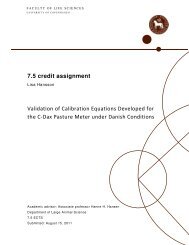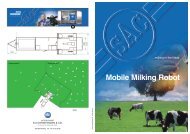Innovative Technology and Sustainable Development of Organic - 1.
Innovative Technology and Sustainable Development of Organic - 1.
Innovative Technology and Sustainable Development of Organic - 1.
You also want an ePaper? Increase the reach of your titles
YUMPU automatically turns print PDFs into web optimized ePapers that Google loves.
3.<strong>1.</strong> Introduction<br />
<strong>Organic</strong> dairy farms in Denmark exp<strong>and</strong> in herd size, annual milk yield per cow increases <strong>and</strong> farmers<br />
are improving efficiency (Kristensen et al., 2005). Introduction <strong>of</strong> new technology is part <strong>of</strong> this<br />
development. To save labour costs when suitable labour is scarce, expensive automatic milking<br />
systems (AMS) are being implemented, <strong>and</strong> information <strong>and</strong> communication technology (ICT) is used.<br />
AMS use on conventional dairy farms has been subject to evaluation, but first after the year 2000 it<br />
was no longer obstructed by technological inadequacies (Meijering et al., 2004). New technologies are<br />
<strong>of</strong>ten contentious <strong>and</strong> tend to provoke skepticism <strong>and</strong> need general comprehension before public<br />
acceptance (Meskens <strong>and</strong> Mathijs, 2002). This can be expected especially for the use <strong>of</strong> AMS<br />
technology on organic farms, where other principles on areas such as animal health <strong>and</strong> welfare,<br />
feeding, <strong>and</strong> marketing have to be addressed, than on conventional farms (Oudshoorn et al., 2008).<br />
Assessment <strong>of</strong> the AMS use on organic dairy farms was found necessary.<br />
As organic agriculture claims to be a sustainable alternative (Oudshoorn <strong>and</strong> De Boer, 2005), a<br />
sustainability assessment using a 4-step methodology as defined <strong>and</strong> applied by Mollenhorst <strong>and</strong> de<br />
Boer (2004) was used. The 4 steps comprise: (1) definition <strong>of</strong> the cause <strong>of</strong> action, (2) identification <strong>and</strong><br />
definition <strong>of</strong> relevant sustainability issues, (3) selection <strong>and</strong> quantification <strong>of</strong> sustainability indicators,<br />
(4) assessment <strong>of</strong> the consequences for sustainable development. <strong>Sustainable</strong> development has over the<br />
years been accepted as a development that meets the needs <strong>of</strong> current generations without<br />
compromising future generations. To ensure needs <strong>of</strong> today <strong>and</strong> needs <strong>and</strong> aspirations <strong>of</strong> future<br />
generations, economic, ecological, <strong>and</strong> societal issues (EES) should be considered simultaneously (De<br />
Boer <strong>and</strong> Cornelissen, 2002). For step 1 <strong>and</strong> 2 <strong>of</strong> the methodology, a literature survey on sustainability<br />
for conventional farming using AMS, was carried out <strong>and</strong> scrutinized for organic implementation<br />
(Oudshoorn <strong>and</strong> De Boer, 2005). Selected organic stakeholders gave their opinion on perceptions <strong>of</strong> the<br />
use <strong>of</strong> AMS which supplemented the theoretical selection <strong>of</strong> EES issues, relevant to assess the<br />
sustainability <strong>of</strong> organic farms using AMS (Oudshoorn et al., 2008). In order to complete the<br />
sustainability assessment according to the 4-step methodology, sustainability indicators (SI) were<br />
selected for the identified issues. AMS implementation has interdependent consequences at farm level.<br />
The drive to invest <strong>of</strong>ten requires higher economic returns, possibly influencing intensity <strong>of</strong> production<br />
<strong>and</strong> influencing environmental constraints (Haas et al., 2007). Quantification was performed on farm<br />
basis, so consequences <strong>of</strong> AMS for a sustainable development, comprising all EES issues, could be<br />
determined. On farm quantification <strong>of</strong> selected indicators gives the possibility for interdisciplinary<br />
assessment <strong>of</strong> sustainability (Mollenhorst <strong>and</strong> De Boer, 2004). The objective <strong>of</strong> this research, therefore,<br />
was to assess the EES consequences <strong>of</strong> use <strong>of</strong> AMS on organic dairy farms, by comparing selected<br />
EES indicators <strong>of</strong> organic dairy farms using AMS with organic dairy farms using a conventional<br />
milking system (CMS).<br />
3.2 Materials <strong>and</strong> Methods<br />
3.2.1 Selection <strong>of</strong> Farms<br />
In 2005, there were 480 active organic dairy farms in Denmark, <strong>of</strong> which 45 had AMS. Twenty farms<br />
were r<strong>and</strong>omly picked from the organic dairy authorization archive <strong>of</strong> which 10 used AMS <strong>and</strong> 10 used<br />
CMS. From each group, 9 farmers responded positively to the request to share performance data <strong>and</strong><br />
complete a questionnaire. Beforeh<strong>and</strong> the archive had been filtered, allowing only the Holstein Frisian<br />
(HF) breed (85% <strong>of</strong> all organic herds in 2005) to be included, in order to avoid breed differences in the<br />
Thesis Frank W. Oudshoorn 41




